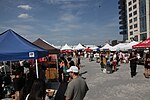14th Street Tunnel shutdown

The 14th Street Tunnel shutdown (also referred to as the L Project, the L train shutdown, or the Canarsie Tunnel reconstruction) was the partial closure and reconstruction of the New York City Subway's 14th Street Tunnel that took place from April 2019 to April 2020. The tunnel carries the BMT Canarsie Line (serving the L train) under the East River in New York City, connecting the boroughs of Brooklyn and Manhattan, and is used by an average of 225,000 passengers per weekday. A key segment of the 14th Street Tunnel, between the Bedford Avenue station in Brooklyn and the First Avenue station in Manhattan, would be partially closed for 15 to 20 months to allow for necessary and extensive repairs to the underwater tubes after it was flooded and severely damaged during Hurricane Sandy in 2012. Two options were proposed in 2016: a three-year construction period where one tube at a time would be closed or an 18-month closure where both tubes would be worked on simultaneously. The Metropolitan Transportation Authority ultimately chose the 18-month closure option because it would be less disruptive to passenger service. The shutdown period was later reduced to 15 months to reduce service disruption. To accommodate displaced passengers, new or expanded bus, subway, and ferry service was to be added, and a 14th Street busway would have been implemented. The shutdown plan was criticized by riders who use the L train and people living along or near 14th Street in Manhattan, as it would have had adverse effects on other subway routes and on vehicular traffic. In January 2019, it was announced that the shutdown would not be a full-time closure, but a night and weekend closure. Ultimately, the line was not closed; night and weekend service was merely reduced.
Excerpt from the Wikipedia article 14th Street Tunnel shutdown (License: CC BY-SA 3.0, Authors, Images).14th Street Tunnel shutdown
North 5th Street, New York Brooklyn
Geographical coordinates (GPS) Address Nearby Places Show on map
Geographical coordinates (GPS)
| Latitude | Longitude |
|---|---|
| N 40.724 ° | E -73.967 ° |
Address
Crescendo
North 5th Street
11211 New York, Brooklyn
New York, United States
Open on Google Maps









